介词 for with 的用法小结
介词in,on.at,for.with,by,of的基本用法
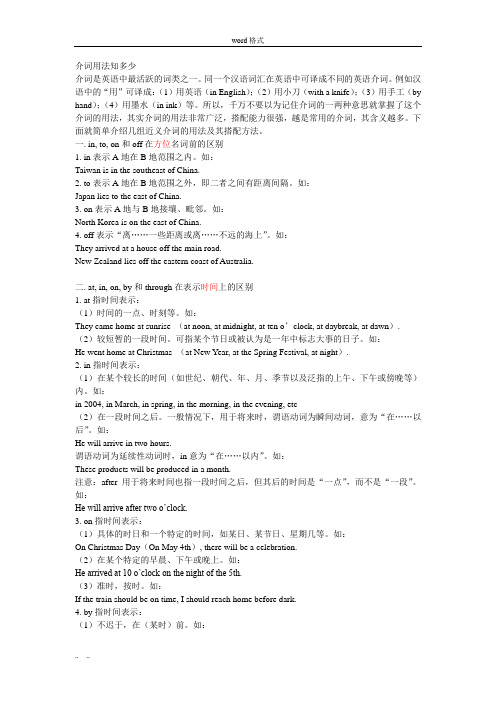
介词用法知多少介词是英语中最活跃的词类之一。
同一个汉语词汇在英语中可译成不同的英语介词。
例如汉语中的“用”可译成:(1)用英语(in English);(2)用小刀(with a knife);(3)用手工(by hand);(4)用墨水(in ink)等。
所以,千万不要以为记住介词的一两种意思就掌握了这个介词的用法,其实介词的用法非常广泛,搭配能力很强,越是常用的介词,其含义越多。
下面就简单介绍几组近义介词的用法及其搭配方法。
一. in, to, on和off在方位名词前的区别1. in表示A地在B地范围之内。
如:Taiwan is in the southeast of China.2. to表示A地在B地范围之外,即二者之间有距离间隔。
如:Japan lies to the east of China.3. on表示A地与B地接壤、毗邻。
如:North Korea is on the east of China.4. off表示“离……一些距离或离……不远的海上”。
如:They arrived at a house off the main road.New Zealand lies off the eastern coast of Australia.二. at, in, on, by和through在表示时间上的区别1. at指时间表示:(1)时间的一点、时刻等。
如:They came home at sunrise (at noon, at midnight, at ten o’clock, at daybreak, at dawn). (2)较短暂的一段时间。
可指某个节日或被认为是一年中标志大事的日子。
如:He went home at Christmas (at New Year, at the Spring Festival, at night).2. in指时间表示:(1)在某个较长的时间(如世纪、朝代、年、月、季节以及泛指的上午、下午或傍晚等)内。
about,with,of,for,to用法
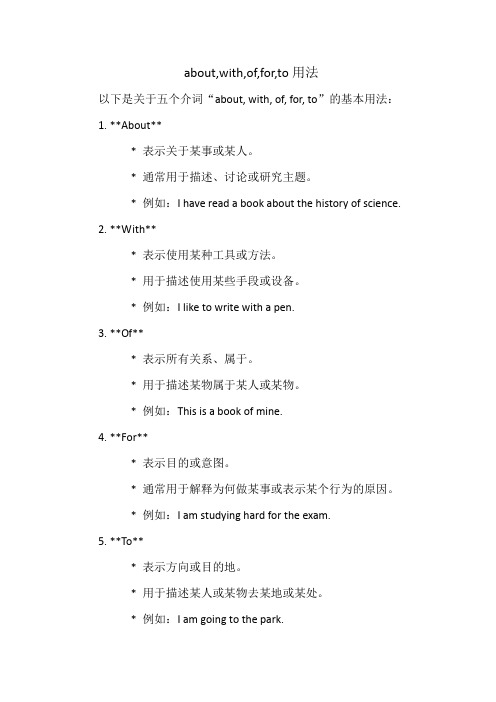
about,with,of,for,to用法
以下是关于五个介词“about, with, of, for, to”的基本用法:1. **About**
* 表示关于某事或某人。
* 通常用于描述、讨论或研究主题。
* 例如:I have read a book about the history of science.
2. **With**
* 表示使用某种工具或方法。
* 用于描述使用某些手段或设备。
* 例如:I like to write with a pen.
3. **Of**
* 表示所有关系、属于。
* 用于描述某物属于某人或某物。
* 例如:This is a book of mine.
4. **For**
* 表示目的或意图。
* 通常用于解释为何做某事或表示某个行为的原因。
* 例如:I am studying hard for the exam.
5. **To**
* 表示方向或目的地。
* 用于描述某人或某物去某地或某处。
* 例如:I am going to the park.
这五个介词的用法相当复杂,因此建议查阅英语语法书籍或咨询英语教师,以获取更详细和准确的信息。
介词in,on.at,for.with,by,of的基本用法之欧阳地创编
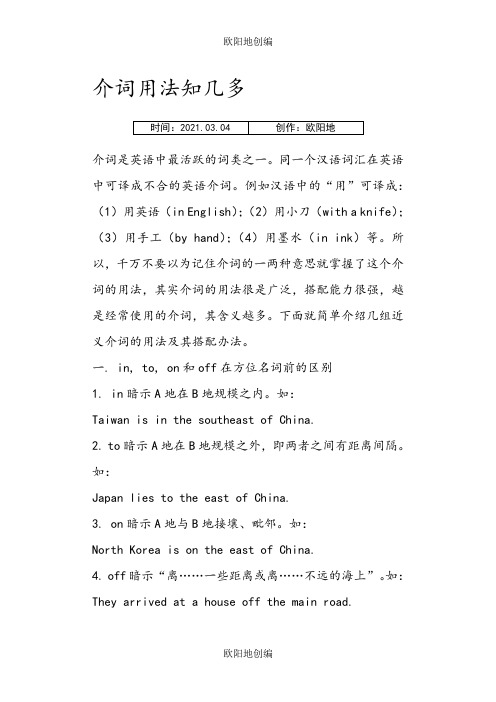
介词用法知几多介词是英语中最活跃的词类之一。
同一个汉语词汇在英语中可译成不合的英语介词。
例如汉语中的“用”可译成:(1)用英语(in English);(2)用小刀(with a knife);(3)用手工(by hand);(4)用墨水(in ink)等。
所以,千万不要以为记住介词的一两种意思就掌握了这个介词的用法,其实介词的用法很是广泛,搭配能力很强,越是经常使用的介词,其含义越多。
下面就简单介绍几组近义介词的用法及其搭配办法。
一. in, to, on和off在方位名词前的区别1. in暗示A地在B地规模之内。
如:Taiwan is in the southeast of China.2. to暗示A地在B地规模之外,即两者之间有距离间隔。
如:Japan lies to the east of China.3. on暗示A地与B地接壤、毗邻。
如:North Korea is on the east of China.4. off暗示“离……一些距离或离……不远的海上”。
如:They arrived at a house off the main road.New Zealand lies off the eastern coast of Australia.二. at, in, on, by和through在暗示时间上的区别1. at指时间暗示:(1)时间的一点、时刻等。
如:They came home at sunrise (at noon, at midnight, at ten o’clock, at daybreak, at dawn).(2)较长久的一段时间。
可指某个节日或被认为是一年中标记年夜事的日子。
如:He went home at Christmas (at New Year, at the Spring Festival, at night).2. in指时间暗示:(1)在某个较长的时间(如世纪、朝代、年、月、季节以及泛指的上午、下午或傍晚等)内。
高考英语介词of、With、For的用法总结

of的用法一、前面的名词是主语的情况1、[表示所属关系](属于)...的eg:man of that time那个时代的人2、[表示关于](关于)...的eg:a long story of adventure一个很长的冒险故事二、短语是主语的情况1、[表示同位关系] eg:the city of Rome罗马市2、[表示性质、内容、状况等] eg:a look of pity令人哀怜的神色3、[表示在...方面] eg:be quick of eye眼快三、后面的名词是主语的情况1、[表示数量、种类] eg:three pieces of meat三块肉2、[表示部分或全部] eg:five of us我们中五个人3、[表示...中最突出的] eg:the hero of heroes最杰出的英雄4、[表示由...组成、做成] eg:a table of wood木头桌子5、[表示动作的主体] eg:It is clever of you to do so.你那样做真聪明。
With的用法1、以用同...由于和...一致赞成关于就talk with a friend 与朋友谈话learn farming with an old peasant 跟老农学习种田fight [quarrel argue] with sb. 跟某人打架[争吵辩论]2、说明表示动作的词表示伴随]随着和...同时change with the temperature 随着温度而变化increase with years 逐年增加be up with the dawn 黎明即起W-these words he left the room. 他说完这些话便离***间。
3、表示使用的工具手段用defend the motherland with one's life 用生命保卫祖国dig with a pick 用镐挖掘cut meat with a knife 用刀割肉4、明名词表示事物的附属部分或所具有的性质]具有; 带有; 加上; 包括...在内tea with sugar 加糖的茶水a country with a long history 历史悠久的国家5、表示一致]在...一边与...一致; 拥护有利于vote with sb. 投票赞成某人sympathize with sb. 同情某人be with sb. 赞成某人在某人一边6、[表示随身携带]在...身边Have you some money with you ? 你(身上)带钱了吗?Take an umbrella with you. 随身带把伞去。
介词in,on.at,for.with,by,of的基本用法

介词用法知多少介词是英语中最活跃的词类之一。
"同一个汉语词汇在英语中可译成不同的英语介词。
例如汉语中的“用”可译成:(1)用英语(in English);(2)用小刀(with a knife);(3)用手工(byhand);(4)用墨水(in ink)等。
所以,千万不要以为记住介词的一两种意思就掌握了这个介词的用法,其实介词的用法非常广泛,搭配能力很强,越是常用的介词,其含义越多。
下面就简单介绍几组近义介词的用法及其搭配方法。
一. in, to, on和off在方位名词前的区别1. in表示A地在B地范围之内。
如:Taiwan is in the southeast of China.2. to表示A地在B地范围之外,即二者之间有距离间隔。
如:Japan lies to the east of China.3. on表示A地与B地接壤、毗邻。
如:North Korea is on the east of China.4. off表示“离……一些距离或离……不远的海上”。
如:They arrived at a house off the main road.New Zealand lies off the eastern coast of Australia.二. at, in, on, by和through在表示时间上的区别1. at指时间表示:(1)时间的一点、时刻等。
如:They came home at sunrise(at noon, at midnight, at ten o’clock, at daybreak, at dawn).(2)较短暂的一段时间。
可指某个节日或被认为是一年中标志大事的日子。
如:He went home at Christmas(at New Year, at the Spring Festival, at night).2. in指时间表示:(1)在某个较长的时间(如世纪、朝代、年、月、季节以及泛指的上午、下午或傍晚等)内。
from,with,for的用法

from, with, for的用法一、from的用法1. 表示来源from可用来表示事物、地点、人等的来源或者出处,表示“从……来”、“出自”、“起源于”等意义。
例句:The book is from the library.(这本书是从图书馆来的。
)2. 表示原因from还可以用来表示原因,表示“出于”、“从……获得”等意义。
例句:I am suffering from a bad cold.(我患上了严重的感冒。
)3. 表示时间、距离、数量等from还可以表示时间、距离、数量等的起点,表示“从……起”、“从……来”等意义。
例句:The bus runs from 8:00 a.m. to 5:00 p.m.(公交车每天从上午8点运行到下午5点。
)二、with的用法1. 表示伴随with可用来表示动作伴随一个动作或状态进行,表示“与……一起”、“随同”等意义。
例句:She is dancing with her friends.(她和她的朋友一起跳舞。
)2. 表示使用工具、手段with还可以表示使用工具或手段。
例句:I cut the paper with scissors.(我用剪刀剪纸。
)3. 表示具备with还可以表示某人或某事物具备某种特征或品质。
例句:I was impressed with her performance.(她的表现让我印象深刻。
)三、for的用法1. 表示目的for可用来表示目的,表示“为了”、“用于”、“以便”等意义。
例句:She bought some flowers for her mother.(她为她的母亲买了一些花。
)2. 表示时间、距离、数量等for还可以表示时间、距离、数量等,表示“对……而言”的意义。
例句:I have lived in this city for ten years.(我在这座城市住了十年。
)3. 表示代替for还可以表示代替。
介词in,on.at,for.with,by,of的基本用法
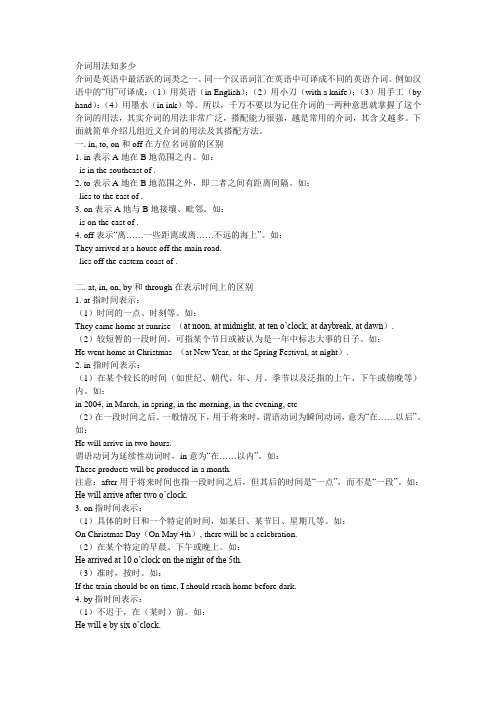
介词用法知多少介词是英语中最活跃的词类之一。
同一个汉语词汇在英语中可译成不同的英语介词。
例如汉语中的“用”可译成:(1)用英语(in English);(2)用小刀(with a knife);(3)用手工(by hand);(4)用墨水(in ink)等。
所以,千万不要以为记住介词的一两种意思就掌握了这个介词的用法,其实介词的用法非常广泛,搭配能力很强,越是常用的介词,其含义越多。
下面就简单介绍几组近义介词的用法及其搭配方法。
一. in, to, on和off在方位名词前的区别1. in表示A地在B地范围之内。
如:is in the southeast of .2. to表示A地在B地范围之外,即二者之间有距离间隔。
如:lies to the east of .3. on表示A地与B地接壤、毗邻。
如:is on the east of .4. off表示“离……一些距离或离……不远的海上”。
如:They arrived at a house off the main road.lies off the eastern coast of .二. at, in, on, by和through在表示时间上的区别1. at指时间表示:(1)时间的一点、时刻等。
如:They came home at sunrise (at noon, at midnight, at ten o’clock, at daybreak, at dawn).(2)较短暂的一段时间。
可指某个节日或被认为是一年中标志大事的日子。
如:He went home at Christmas (at New Year, at the Spring Festival, at night).2. in指时间表示:(1)在某个较长的时间(如世纪、朝代、年、月、季节以及泛指的上午、下午或傍晚等)内。
如:in 2004, in March, in spring, in the morning, in the evening, etc(2)在一段时间之后。
for和with的用法与区别
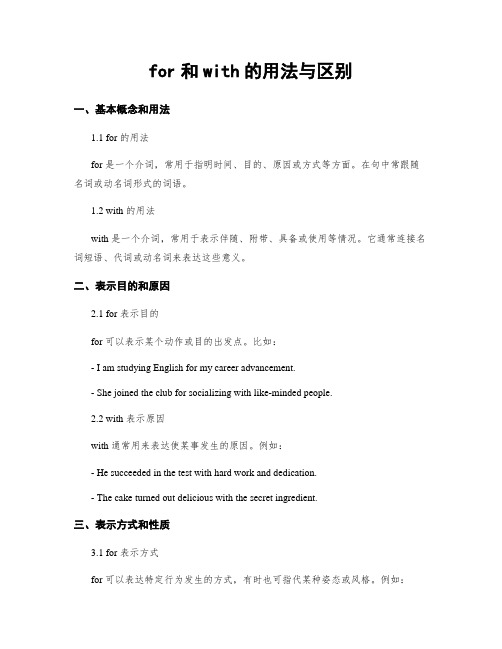
for和with的用法与区别一、基本概念和用法1.1 for 的用法for 是一个介词,常用于指明时间、目的、原因或方式等方面。
在句中常跟随名词或动名词形式的词语。
1.2 with 的用法with 是一个介词,常用于表示伴随、附带、具备或使用等情况。
它通常连接名词短语、代词或动名词来表达这些意义。
二、表示目的和原因2.1 for 表示目的for 可以表示某个动作或目的出发点。
比如:- I am studying English for my career advancement.- She joined the club for socializing with like-minded people.2.2 with 表示原因with 通常用来表达使某事发生的原因。
例如:- He succeeded in the test with hard work and dedication.- The cake turned out delicious with the secret ingredient.三、表示方式和性质3.1 for 表示方式for 可以表达特定行为发生的方式,有时也可指代某种姿态或风格。
例如:- He shot the target with perfect aim.- She danced for joy when she heard the good news.3.2 with 表示具备性质with 还可以表示某种特定属性或性质与某人或物体有关联。
举个例子:- My father is a man with great wisdom and knowledge.- This car is equipped with advanced safety features.四、表示伴随和使用4.1 for 表示伴随for 在某些情况下可以表示某人或物与其他人或事情一起,成为一种伴随关系。
- 1、下载文档前请自行甄别文档内容的完整性,平台不提供额外的编辑、内容补充、找答案等附加服务。
- 2、"仅部分预览"的文档,不可在线预览部分如存在完整性等问题,可反馈申请退款(可完整预览的文档不适用该条件!)。
- 3、如文档侵犯您的权益,请联系客服反馈,我们会尽快为您处理(人工客服工作时间:9:00-18:30)。
介词for 的用法小结
1. 表示“当作、作为”。
如:
I like some bread and milk for breakfast. 我喜欢把面包和牛奶作为早餐。
What will we have for supper? 我们晚餐吃什么?
2. 表示理由或原因,意为“因为、由于”。
如:
Thank you for helping me with my English. 谢谢你帮我学习英语。
Thank you for your last letter. 谢谢你上次的来信。
Thank you for teaching us so well. 感谢你如此尽心地教我们。
3. 表示动作的对象或接受者,意为“给……”、“对…… (而言)”。
如:
Let me pick it up for you. 让我为你捡起来。
Watching TV too much is bad for your health. 看电视太多有害于你的健康。
4. 表示时间、距离,意为“计、达”。
如:
I usually do the running for an hour in the morning. 我早晨通常跑步一小时。
We will stay there for two days. 我们将在那里逗留两天。
5. 表示去向、目的,意为“向、往、取、买”等。
如:
Let’s go for a walk. 我们出去散步吧。
I came here for my schoolbag.我来这儿取书包。
I paid twenty yuan for the dictionary. 我花了20元买这本词典。
6. 表示所属关系或用途,意为“为、适于……的”。
如:
It’s time for school. 到上学的时间了。
Here is a letter for you. 这儿有你的一封信。
7. 表示“支持、赞成”。
如:
Are you for this plan or against it? 你是支持还是反对这个计划?
8. 用于一些固定搭配中。
如:
Who are you waiting for? 你在等谁?
For example, Mr Green is a kind teacher. 比如,格林先生是一位心地善良的老师。
介词with的用法小结
with 是介词,但其意义颇多,一时难掌握。
为帮助大家理清头绪,请允许我以教材中的句子为例,进行分类,并配以简单的解释,为同学作一个全屏显示。
你们可要看好哟!
1. 带着,牵着…… (表动作特征)。
如:
Run with the kite like this.
2. 附加、附带着……(表事物特征)。
如:
A glass of apple juice, two glasses of coke, two hamburgers with potato chips, rice and fish.
3. 和…… (某人)一起。
a. 跟某人一起(居住、吃、喝、玩、交谈……) 。
如:
Now I am in China with my parents.
Sometimes we go out to eat with our friends.
He / She's talking with a friend.
b. 跟go, come 连用,有"加入"到某方的意思。
如:
Do you want to come with me?
4. 和play一起构成短语动词play
with 意为"玩耍……,玩弄……" 如:
Two boys are playing with their yo-yos.
5. 与help 一起构成help...with...句式,意为"帮助(某人) 做(某事)"。
如:
On Monday and Wednesday, he helps his friends with their English.
6. 表示面部神情,有"含着……,带着……" 如:
"I'm late for school," said Sun Y ang, with tears in his eyes.
7. 表示"用……" 如:
Y ou play it with your feet.
What do the farmers do with your machines?
8. 表示"对……,关于……"。
如:
What's wrong with it?
There's something wrong with my computer.。
